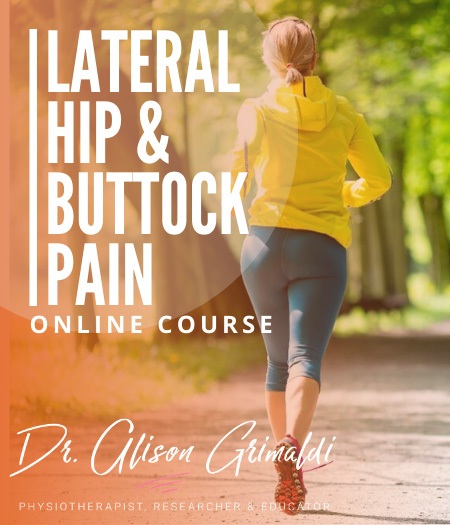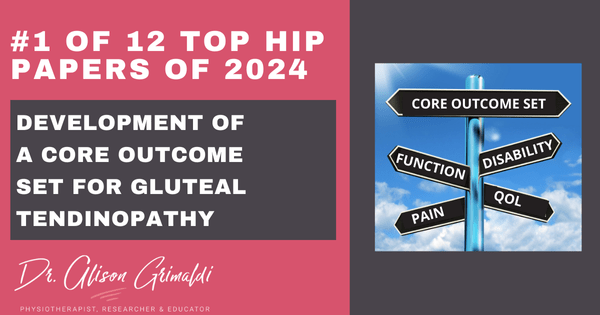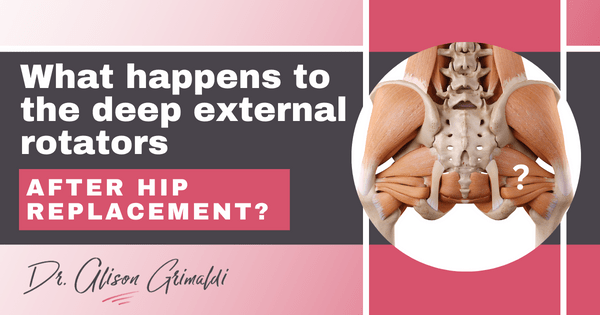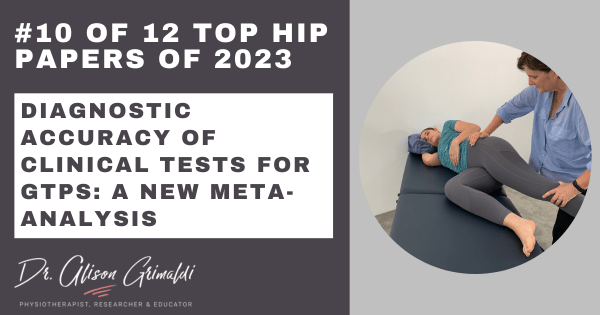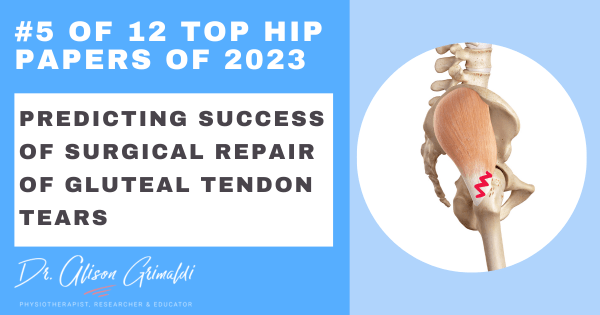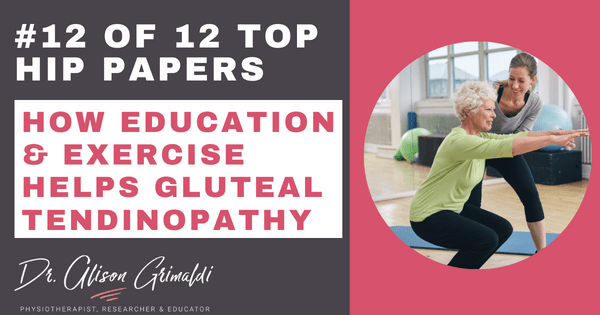What happens to the deep external rotators after hip replacement

Total hip arthroplasty (total hip replacement) is one of the most successful operations performed on the human body. However, persistent pain or disability following surgery is often related to impact on the soft tissues surrounding the joint – either direct surgical damage or secondary impacts related to prosthetic selection or placement. The deep external rotators after total hip replacement surgery may weaken, atrophy, become impinged and a source of pain. There are also considerations for the effect of deep rotator damage on prosthetic stability and longevity.
We are going to explore what is known about the deep external rotators after hip replacement over the next 2 blogs. In this blog we’ll look at deep hip rotator muscle damage during surgery and the aftereffects, and in the next blog we’ll review deep external rotator impingement after hip replacement.
Here are the main topics we’ll be covering in this blog:
- Which deep rotators are released in common surgical approaches to total hip arthroplasty?
- Deep rotator atrophy and fatty infiltration after total hip arthroplasty
- The impact of deep external rotator deficiency following total hip replacement
- Clinical take home messages about deep rotators after hip replacement
What are the deep hip external rotator muscles?
The deep hip external rotator group includes 6 muscles:
- the piriformis muscle,
- the obturator internus muscle,
- the superior gemellus muscle,
- the inferior gemellus muscle,
- obturator externus, and
- the quadratus femoris muscle.
The superior and inferior gemelli muscles blend with the obturator internus as it runs across the back of the hip, inserting together into the medial surface greater trochanter as a ‘conjoined tendon’. Sometimes the piriformis tendon also blends with this tendon.


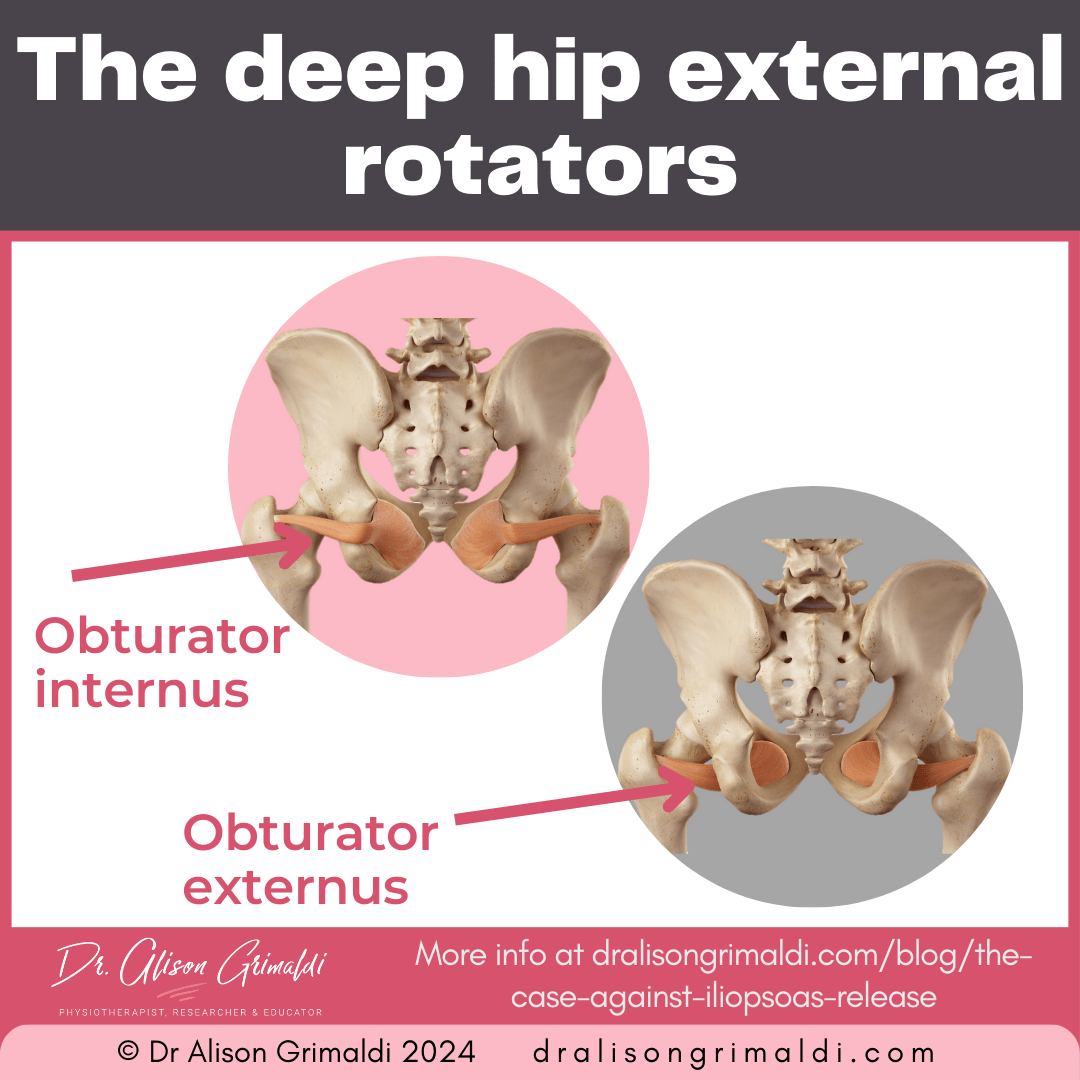
Which deep rotators are released in common surgical approaches to total hip arthroplasty?
The 3 main approaches to the hip when performing total hip arthroplasty are from the back (posterior approach), the side (lateral approach), or the front (anterior approach), with variations of each. The lateral approach is less favoured from a muscle sparing perspective, due to the impact on the gluteus medius and minimus muscles.
A posterior approach has been reported to still be the most commonly used technique worldwide,1,2 although anterior approaches are now very popular and have become the predominant approach in many regions.
Iatrogenic injury to the deep external rotators during hip arthroplasty is a well-known complication of posterior approach surgeries. However, many non-surgical healthcare practitioners are not aware of the impact of anterior approach surgeries on the deep hip external rotators.
Modern muscle sparing techniques aim to minimize muscle damage and potential sequelae, but can we just assume then that muscle sparing approaches are successful in ‘sparing muscles’?
Let’s first review the main surgical approaches to total hip arthroplasty and then we’ll look at how the deep rotators fare after each, and the potential impact this may have.
H3 Posterior approach total hip arthroplasty and the deep hip rotators
Posterior or posterolateral approaches involve detachment of the posterior capsule, with varying degrees of detachment and repair of the deep hip external rotators. The conjoined tendon of the obturator internus and gemelli are always detached with the capsule. The obturator externus is usually also detached.
The piriformis tendon was previously routinely detached, particularly if the patient had the common anatomical variation where the piriformis tendon blends with the conjoined tendon. The proximal half of quadratus femoris is usually detached in a traditional posterior approach, but some modern techniques aim to spare this muscle.
Modern techniques aim to preserve some of these structures, with varying focus. For example, the Piriformis Sparing Posterior Approach2,3 aims to preserve the piriformis attachment, while the SPARTAQUUS technique aims to Spare the Piriformis And Respect The Active QUadratus femoris and gluteus mediUS.1
The posterior capsule is now routinely bone anchored back onto the femur, but the deep rotator tendons themselves may not always be specifically reattached, one paper citing difficulties with suturing tissues due to poor tissue quality.1
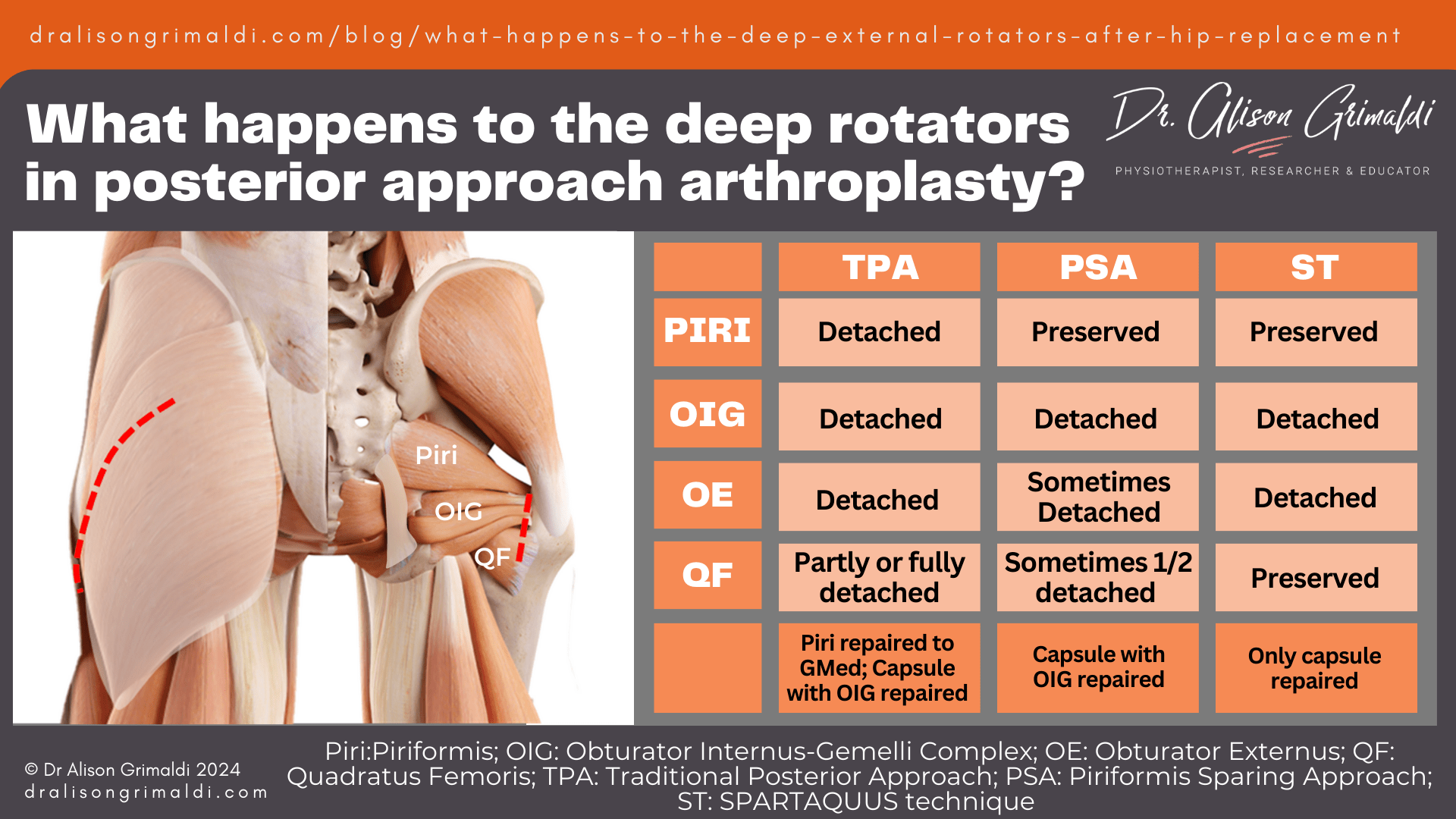
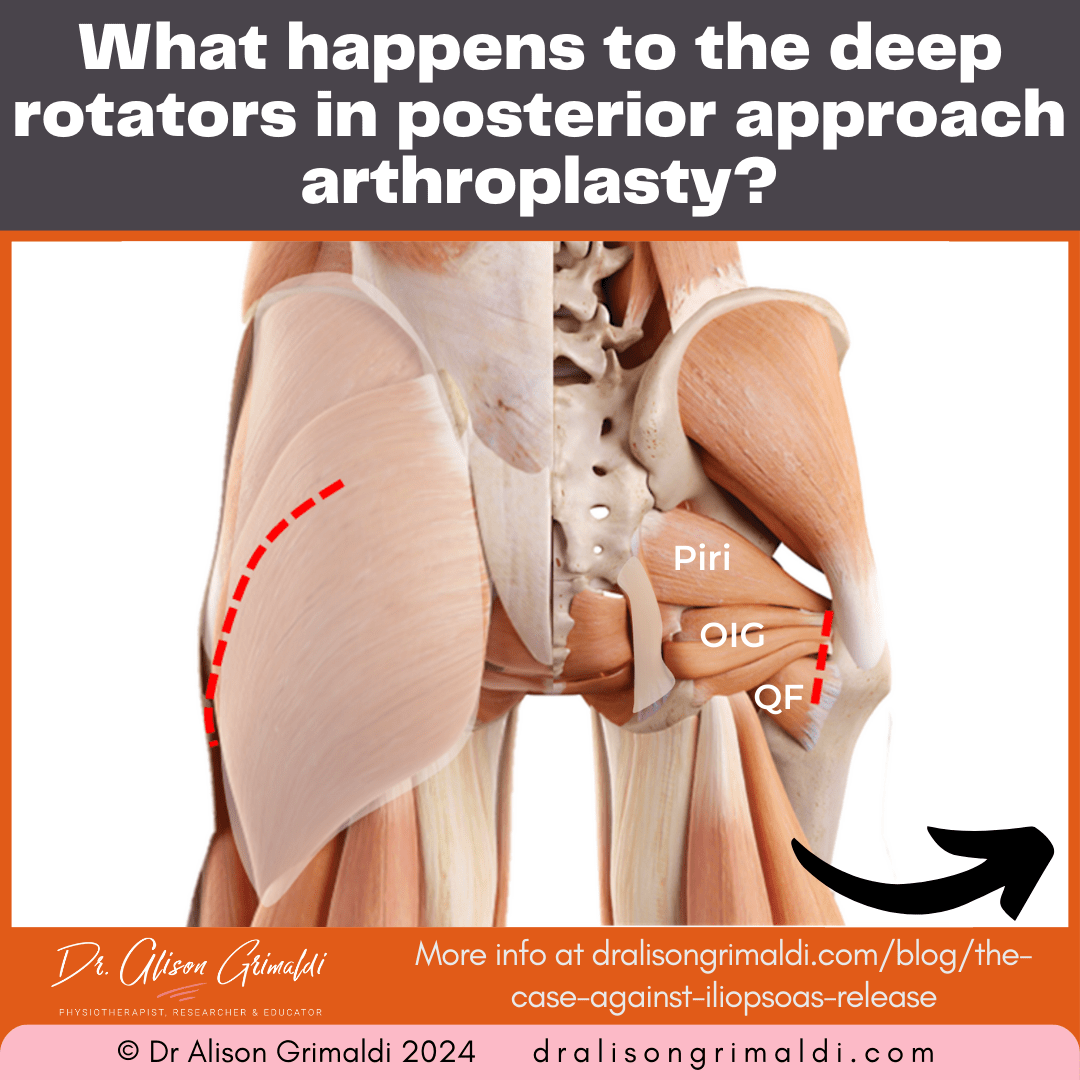

Would you like to learn more about the deep external rotators??
My Lateral Hip and Buttock Pain online course is for you! Upskill assessment and management of joint, tendon and nerve related lateral hip and buttock pain. Signup today!
Anterior and anterolateral approach total hip arthroplasty and the deep hip rotators
There are 2 main anterior approaches:
i) the direct anterior approach, which accesses the hip between the rectus femoris and tensor fascia lata muscle, and
ii) the anterolateral approach, which accesses the hip between the gluteus medius and tensor fascia lata muscle.
Both of these techniques are labelled as ‘muscle sparing’ approaches, because there is no need to detach or cut any of the anterior musculature. The muscles are divided through fascial dissection and retracted to enter the joint.
Are you aware that in 'muscle-sparing' anterior approach hip replacement surgery, the deep external rotators and often released or damaged?
Release of the soft tissues from the medial surface of the greater trochanter is often necessary in anterior approach surgeries to allow adequate elevation and visualization of the femoral shaft, for accurate placement of the femoral stem.
What soft tissues are on the medial surface of the greater trochanter?
- the hip joint capsule,
- the conjoined tendon of obturator internus and gemelli,
- the obturator externus
- +/- the piriformis, depending on individual anatomy.

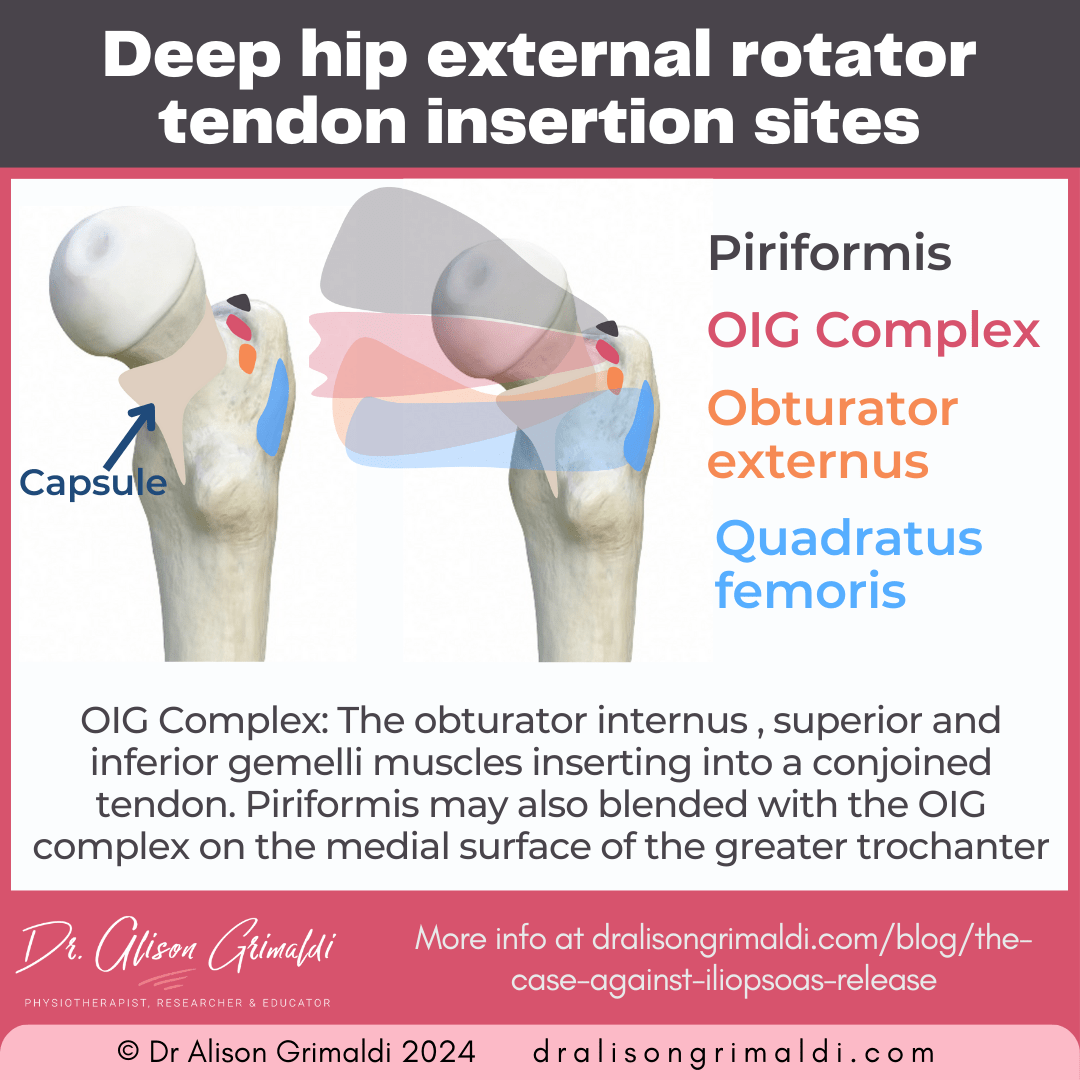
Some surgeons report releasing only the capsule, while others report additional release of the conjoined tendon and sometimes the piriformis tendon.4 In one prospective MRI study of 21 patients following direct anterior approach arthroplasty, 5 patients had no detachment of the deep rotator tendons, in 4 patients only the conjoined tendon was released and in the remaining 12 patients both the conjoined and piriformis tendons were released. All patients still had an intact obturator externus tendon.
Tanaka and colleagues (2024) reported that the conjoined tendon was detached in 58.3% of 87 patients during anterolateral approach total hip arthroplasty.5
In these anterior approaches, detachment of the deep external rotators is not repaired, due to inadequate exposure and access to these posterior muscles and their tendons following release. But perhaps the tendons just heal anyway?
Eilander and colleagues (2023) recently aimed to answer this question and found that external rotator tendons released during direct anterior approach total hip arthroplasty DO NOT HEAL.4
The deep rotator tendons may also be damaged during hip arthroplasty due to denervation of these muscles when elevating the femur to prepare the femoral canal or insert the stem.6
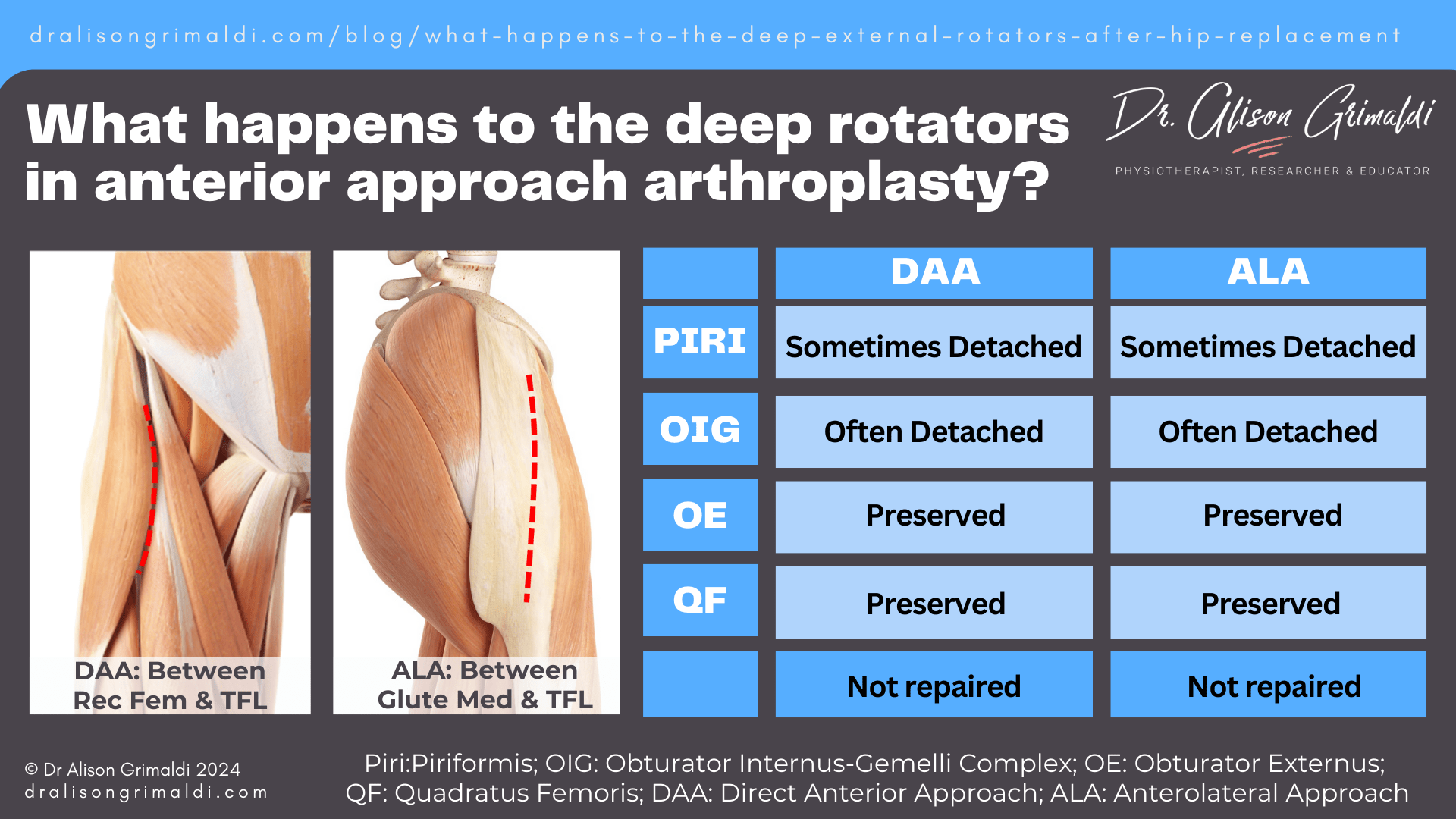

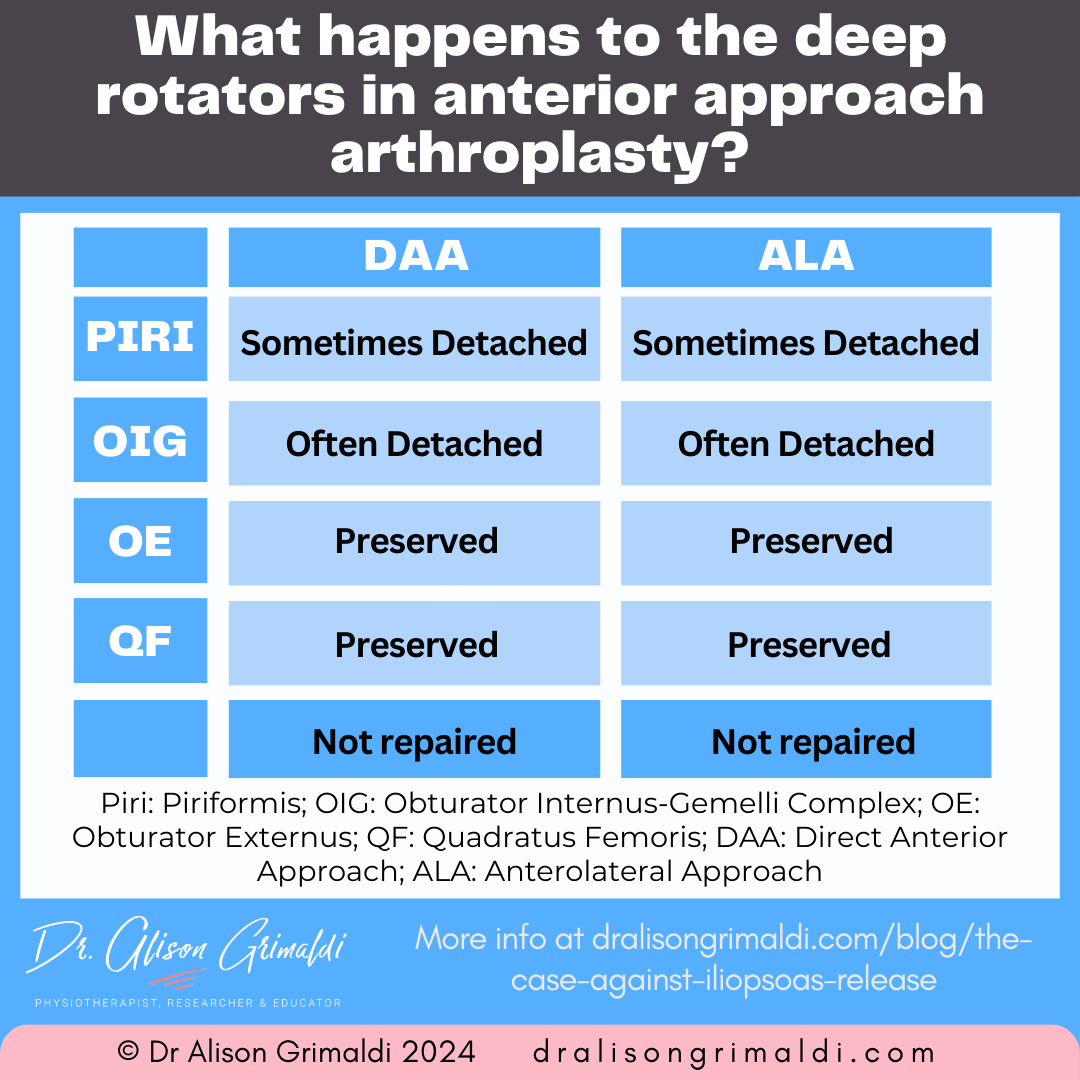
Discover our Lateral Hip & Buttock Pain Course
If you enjoyed this blog, you might like to take the online course on Anterior Hip & Groin Pain - 6 hours of guided online video content. Examine various joint-related, soft tissue-related and nerve-related conditions associated with lateral hip and buttock pain, their mechanisms, associated impairments, clinical diagnostic tests and management approaches. To learn more, take the lateral hip and buttock pain online course, or join me in an online or practical lateral hip and buttock pain workshop.
Deep rotator atrophy and fatty infiltration after total hip arthroplasty
So, we know that tendons of the deep external rotators are necessarily detached to expose the hip joint posteriorly (and usually repaired to some degree at least), and some tendons are quite often released to provide visualization of the femoral shaft in anterior approach ‘muscle sparing’ surgeries (and not repaired).
It is reasonable to expect muscle atrophy after tendon detachment, but there are a few other possible reasons for post-surgical deep external rotator muscle atrophy after hip replacement.
Deep external rotator muscle atrophy and fatty infiltration may occur after arthroplasty due to:
- Tendon release with no repair,
- failed tendon repair,
- muscle injury related to severe traction exerted by retractors, or
- nerve damage from direct scalpel injury or traction injury associated with retractors.
Piriformis atrophy and fatty infiltration after total hip arthroplasty
Piriformis muscle volume has been assessed pre and post-surgery for a couple of surgical approaches:
- Direct anterior approach: mean loss of 23% volume, that did not recover at 12 months.4
- Posterior approach: mean loss of 8% volume, with persistent atrophy at around 6 months.7
Atrophy is also measured through assessment of fatty infiltration of the muscle belly. Fatty infiltration is commonly measured using the Goutallier 0-4 classification, where 0 = no fat in the muscle, up to more severe atrophy where 3 = same amount of fat and muscle within the muscle circumference, and 4 = more fat than muscle.
Substantial (Grade 3-4) fatty infiltration of the piriformis muscle 12 months after hip arthroplasty has been reported for various minimally invasive/muscle sparing approaches:
- Direct anterior approach: 14 - 29% of patients3,6
- Anterolateral approach: 8.3% of patients3
- Piriformis sparing posterior approach: 9.5% of patients3
Lalevée and colleagues’ (2021) MRI study reported no significant mean change in fatty infiltration of the piriformis at 3 or 12 months after a piriformis-sparing posterior approach.2 However, two patients showed atrophy at 1 year, not present preoperatively, both due to avulsion of the piriformis muscle from its sacral origin.
Such irreversible piriformis trauma may occur due to severe traction exerted by the retractors to achieve sufficient visualization of the joint. The surgeon will usually not be aware of these injuries at the time of surgery, especially injuries occurring at the sacral attachment.


Obturator internus atrophy and fatty infiltration after total hip arthroplasty
Obturator internus muscle size has been assessed pre and post surgically:
- Direct anterior approach: mean loss of 27 – 37 % volume, that did not recover at 12 months4,7
- Posterior approach: mean loss of 47% volume, with persistent atrophy at around 6 months7
- Anterolateral approach: ‘slight atrophy’ of obturator internus, in <10% of patients8
The better preservation of OI reported in the anterolateral approach study was achieved by the surgeon paying particular attention to muscle preservation and with careful use of retractors.8
Rates reported for substantial (Grade 3-4) fatty infiltration of the obturator internus muscle 12 months after hip arthroplasty:
- Direct anterior approach: 19% of patients3,6
- Anterolateral approach: 4 – 58 % of patients3,5
- Piriformis sparing posterior approach: 67 - 76% of patients2,3
Obturator externus atrophy and fatty infiltration after total hip arthroplasty
Obturator externus muscle size assessed pre and post total hip replacement surgery:
- Direct anterior approach: no significant loss of volume up to around 6 months post-surgery7
- Posterior approach: mean loss of 16% volume, with persistent atrophy at around 6 months7
- Anterolateral approach: ‘slight atrophy’ of obturator externus, in <10% of patients, using careful attention to muscle preservation and retraction8
Rates reported for substantial (Grade 3-4) fatty infiltration of the obturator externus muscle 12 months after hip arthroplasty:
- Direct anterior approach: no significant change3,6
- Anterolateral approach: no significant change3
- Piriformis sparing posterior approach: 14 - 24% of patients2,3
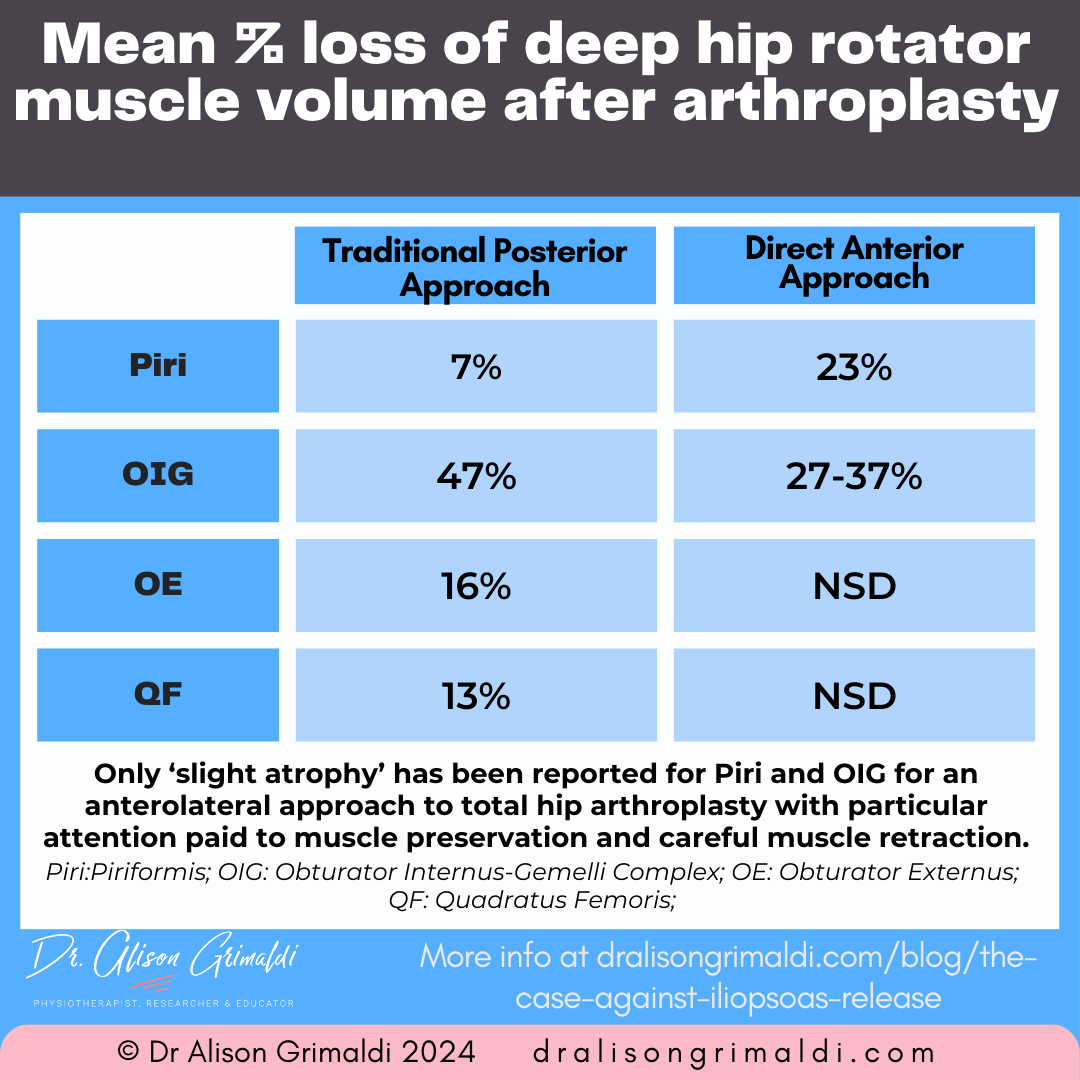

Quadratus femoris atrophy and fatty infiltration after total hip arthroplasty
Quadratus femoris muscle size assessed pre and post total hip arthroplasty:
- Direct anterior approach: no significant loss of volume up to around 6 months post-surgery7
- Posterior approach: mean loss of 13% volume, with persistent atrophy at around 6 months7
- Anterolateral approach: Inadequate information but the quadratus femoris should not be impacted by this approach.
Rates reported for substantial (Grade 3-4) fatty infiltration of the quadratus femoris muscle 12 months after hip arthroplasty:
- Direct anterior approach: no significant change3
- Anterolateral approach: no significant change3
- Piriformis sparing posterior approach: 19 - 29% of patients2,3
Overall, the evidence tells us that the deep external rotators after hip replacement are impacted adversely in a considerable number of people, particularly in posterior approaches but even with minimally invasive anterior procedures, with obturator internus most profoundly affected.
So, are minimally invasive muscle sparing approaches really muscle sparing? This was the conclusion of Lalevée and colleagues3:
“The muscle-sparing properties of minimally invasive hip approaches are only theoretical.”
It seems these procedures are not totally muscle sparing, but does it really matter? Does muscle atrophy of the deep hip stabilisers during total hip arthroplasty have any effect on hip strength, patient rated outcomes, joint stability or longevity?
Discover our Lateral Hip & Buttock Pain Course
If you enjoyed this blog, you might like to take the online course on Anterior Hip & Groin Pain - 6 hours of guided online video content. Examine various joint-related, soft tissue-related and nerve-related conditions associated with lateral hip and buttock pain, their mechanisms, associated impairments, clinical diagnostic tests and management approaches. To learn more, take the lateral hip and buttock pain online course, or join me in an online or practical lateral hip and buttock pain workshop.
Impact of deep external rotator deficiency following total hip replacement
A number of the studies investigating muscle atrophy after total hip replacement also collected data on hip muscle strength and patient rated outcome measures. All studies reported similar findings – that there was no or limited impact on hip external rotation strength or functional outcomes.4,5,7
Tanaka and colleagues went so far as to state that this limited impact ‘indicated the muscle’s potential redundancy.’ Their view is that although preserving the conjoined tendon of obturator internus and the gemelli may enhance stability and prevent atrophy, complications may arise from poor placement of the stem in anterior approaches.5
However, Oda and colleagues appeared to manage to reduce impact on the deep external rotators after hip replacement to less than 10%,8 compared with Tanaka’s 58%,5 with no reported increase in complication in the same anterolateral approach. So perhaps more caution and care could be worthwhile, if even for stability and longevity of the prosthesis.
An unrepaired posterior joint capsule has the strongest odds ratio (creates highest risk) for dislocation following primary total hip arthroplasty.9 Repair of the posterior cuff is known to reduce dislocation rates following a posterior approach arthroplasty.10,11
Anterior approach dislocation rates are generally reported to be low,11 and it is more common that the joint would dislocate anteriorly, but posterior dislocation has been reported to occur, even with anterior approach surgeries.
If the deep rotators make it difficult for surgeons to elevate the femoral head anteriorly, it also stands to reason that those deep rotators may also assist in stabilizing against anterior dislocation. Release and lack of repair of the conjoined and piriformis tendons may contribute to the risk of anterior dislocation following total hip arthroplasty.

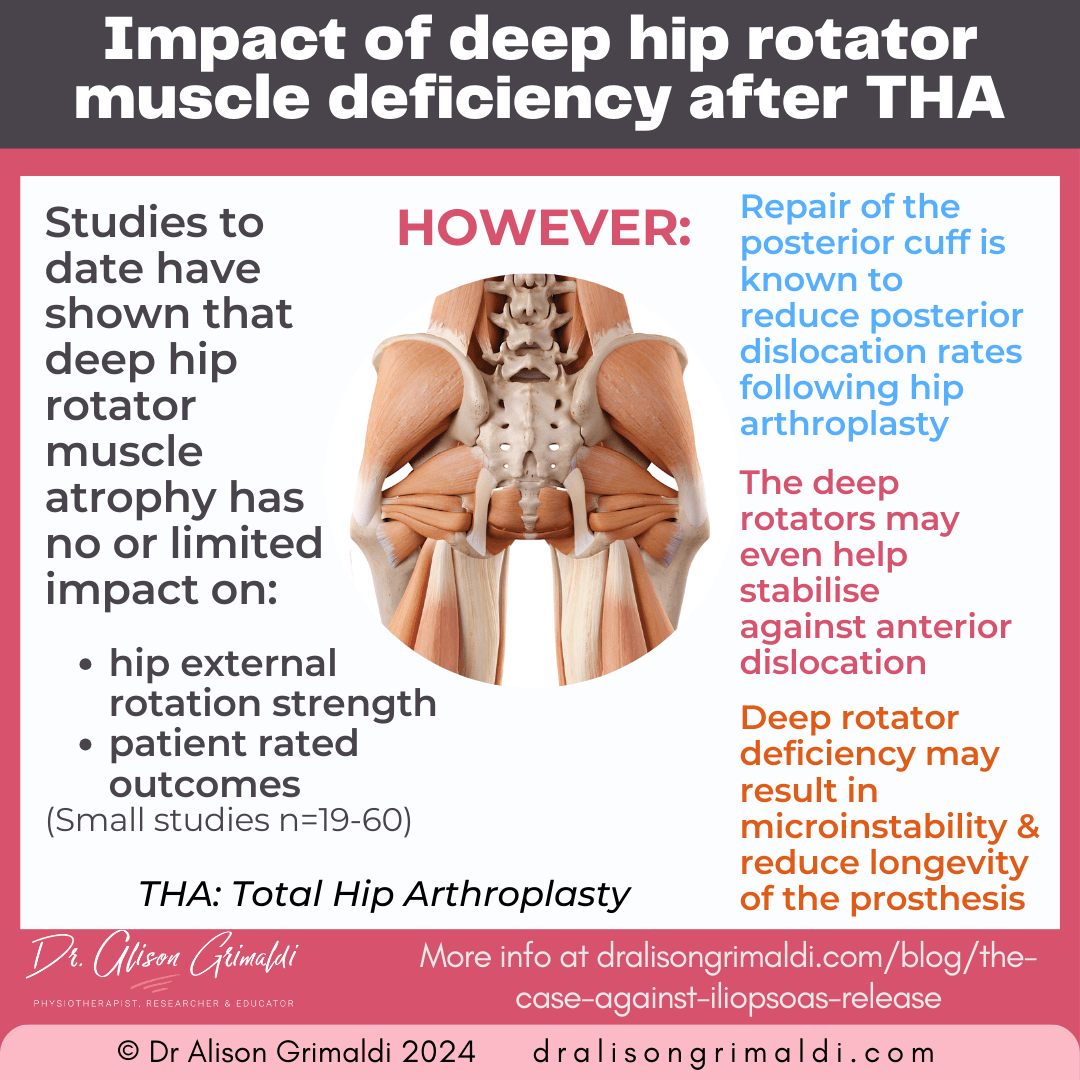
Help more patients with Lateral Hip & Buttock Pain
My Lateral Hip and Buttock Pain online course can provide you with a strategy for working through differential diagnoses and management planning for lateral hip or buttock pain. Establishing a solid foundation of understanding potential conditions and their drivers, and then a framework for logically working through the options, tests to apply and directions for management.
Rehab professionals should be aware of the possibility of reduced dynamic posterior joint support, even in those who have had an anterior approach surgery. The obturator internus and the conjoined tendon pass directly across the posterior aspect of the hip joint, blending with the posterior capsule. This complex is arguably the most important for posterior stability and joint protection and is most adversely impacted by both posterior and anterior approach surgeries.
Apart from dislocation (macroinstability), a devastating complication, deficiencies in the deep external rotators may theoretically also give rise to microinstability following hip replacement. With patients now offered arthroplasty at a younger age, and returning to high volume and impact activities, the life of the prosthesis must be considered.
A prosthetic hip wears over time, in similar patterns as a native hip. Excessive translations of the femoral head in the acetabular cup may accelerate that process. While modern prosthetic materials are much longer wearing and new modular components make revision surgery less traumatic, outcomes of a revision are unlikely to ever match that of the index procedure.
Clinical implications for rehabilitation professionals about deep rotators after hip replacement
Good early care and maintenance of the peri-prosthetic muscles is, in my opinion, likely to be worthwhile. Gross measures of strength of a muscle synergy and global scores on patient rated outcome measures may not adequately elucidate all potential effects of deficiencies in the deep rotators and these muscles should certainly not be considered ‘redundant’.
Here is a summary of clinical implications of this information:
- ‘Muscle-sparing’ total hip arthroplasty approaches do not usually ‘spare’ all hip muscles.
- The deep hip external rotators are routinely detached and repaired to varying degrees after posterior approach arthroplasty.
- The conjoined tendon of obturator internus and gemelli, and sometimes the piriformis tendon are quite often released, and not repaired, in anterior approach surgeries.
- Keep this knowledge in mind when providing post-surgical advice and exercises.
- Atrophy of the deep hip external rotators is common after total hip arthroplasty, even when repair occurs.
- The deep external rotators are important for posterior joint stability – helping protect against macroinstability (dislocation) and microinstability (with possible impacts on prosthetic longevity).
- Optimising deep hip rotator health and function should be considered following total hip replacement surgery.
- Realtime ultrasound allows assessment of most of the deep rotators and is a great option for visual biofeedback.
- Maintaining deep hip rotator muscle size, length and tendon health pre-operatively may improve options for surgical repair and better prepare for surgical impacts and post-operative rehabilitation.
I hope you’ve enjoyed this blog. Keep an eye out for next month’s blog on deep external rotator impingement after hip replacement. Learn more in an online hip course or join me in an upcoming live hip rehabilitation workshop.
Discover our Lateral Hip & Buttock Pain Course
If you enjoyed this blog, you might like to take the online course on Anterior Hip & Groin Pain - 6 hours of guided online video content. Examine various joint-related, soft tissue-related and nerve-related conditions associated with lateral hip and buttock pain, their mechanisms, associated impairments, clinical diagnostic tests and management approaches. To learn more, take the lateral hip and buttock pain online course, or join me in an online or practical lateral hip and buttock pain workshop.

This blog was written by Dr Alison Grimaldi
Dr Alison Grimaldi is a physiotherapist, researcher and educator with over 30 years of clinical experience. She has completed a Bachelor of Physiotherapy, a Masters of Sports Physiotherapy and a PhD, with her doctorate topic in the hip region. Dr Grimaldi is Practice Principal of PhysioTec Physiotherapy in Brisbane and an Adjunct Senior Research Fellow at the University of Queensland. She runs a global Hip Academy and has presented over 100 workshops around the world.
Check Out Some More Relevant Blogs
- Gérard R, Savéan J, Lefèvre C. Minimally invasive posterolateral hip approach with SPARTAQUUS (Spare the Piriformis And Respect The Active QUadratus femoris and gluteus mediUS) technique. Orthop Traumatol Surg Res. 2020 Dec;106(8):1523-1526. doi: 10.1016/j.otsr.2020.07.010. Epub 2020 Nov 8. PMID: 33177007.
- Lalevée M, Matsoukis J, Beldame J, Brunel H, Billuart F, Van Driessche S. MRI assessment of piriformis-sparing posterior approach in total hip arthroplasty. Orthop Traumatol Surg Res. 2021 Dec;107(8):103085. doi: 10.1016/j.otsr.2021.103085. Epub 2021 Sep 25. PMID: 34583011.
- Lalevée M, Curado J, Matsoukis J, Beldame J, Brunel H, Van Driessche S, Billuart F. Comparative MRI assessment of three minimally invasive approaches in total hip arthroplasty. Orthop Traumatol Surg Res. 2022 Oct;108(6):103354. doi: 10.1016/j.otsr.2022.103354. Epub 2022 Jun 15. PMID: 35716987.
- Eilander W, van der Velden E, van Harten M, van Kampen P, Hogervorst T. The short external rotators in the anterior approach hip arthroplasty: do the tendons heal or not? A prospective MRI study. Hip Int. 2023 Sep;33(5):819-827. doi: 10.1177/11207000221107551. Epub 2022 Jun 28. PMID: 35765171.
- Tanaka H, Yamada N, Kurishima H, Mori Y, Aizawa T. Minimal Influence on Muscle Strength and Patient Reported Outcome Measures by Conjoined Tendon Detachment in Anterolateral Muscle-Sparing Total Hip Arthroplasty. Indian J Orthop. 2024 Jan 5;58(2):127-134. doi: 10.1007/s43465-023-01080-5. PMID: 38312900; PMCID: PMC10830953.
- Cailleaud M, Lalevée M, Matsoukis J, Beldame J, Masse M, Billuart F, Van Driessche S. Fatty muscle infiltration of the hip lateral rotator muscles following direct anterior minimally invasive total hip arthroplasty. Orthop Traumatol Surg Res. 2020 Dec;106(8):1515-1521. doi: 10.1016/j.otsr.2020.06.020. Epub 2020 Oct 21. PMID: 33097452.
- Robinson J, Bas M, Deyer T, Cooper HJ, Hepinstall M, Ranawat A, Rodriguez JA. Muscle recovery after total hip arthroplasty: prospective MRI comparison of anterior and posterior approaches. Hip Int. 2023 Jul;33(4):611-619. doi: 10.1177/11207000221114456. Epub 2022 Oct 3. PMID: 36192819.
- Oda S, Hisatome T, Cho E, Fujimaki H, Nakanishi K. MRI Findings of Muscle Damage after Total Hip Arthroplasty Using the Complete Muscle Preserving Anterolateral Supine Approach. Medicina (Kaunas). 2022 May 26;58(6):713. doi: 10.3390/medicina58060713. PMID: 35743976; PMCID: PMC9228776.
- Fessy MH, Putman S, Viste A, et al. What are the risk factors for dislocation in primary total hip arthroplasty? A multicenter case-control study of 128 unstable and 438 stable hips. Orthop Traumatol Surg Res. 2017 Sep;103(5):663-668. doi: 10.1016/j.otsr.2017.05.014. Epub 2017 Jun 16. Erratum in: Orthop Traumatol Surg Res. 2017 Nov;103(7):1137. PMID: 28629944.
- Fujii H, Otani T, Kawaguchi Y, Hayama T, Abe T, Takahashi M, Saito M. Preventing postoperative prosthetic joint dislocation by repairing obturator externus in total hip arthroplasty performed via the posterior approach. Arthroplasty. 2020 Dec 1;2(1):33. doi: 10.1186/s42836-020-00054-4. PMID: 35236447; PMCID: PMC8796350.
- Tay K, Tang A, Fary C, Patten S, Steele R, de Steiger R. The effect of surgical approach on early complications of total hip arthroplasty. Arthroplasty. 2019 Sep 3;1(1):5. doi: 10.1186/s42836-019-0008-2. PMID: 35240769; PMCID: PMC8787926.

